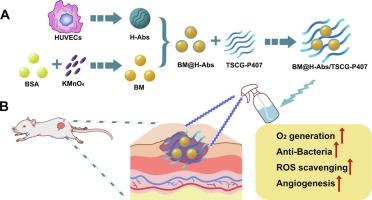Sprayable thermosensitive in-situ gels loaded with apoptotic body-integrated nanozymes for improved diabetic wound healing
IF 4.3
2区 医学
Q1 PHARMACOLOGY & PHARMACY
European Journal of Pharmaceutics and Biopharmaceutics
Pub Date : 2025-07-08
DOI:10.1016/j.ejpb.2025.114807
引用次数: 0
Abstract
Serious vascular dysfunction and recurrent bacterial infection are critical obstacles in diabetic wound healing. Developing novel therapeutic strategies is crucial to address these challenges. Endothelial cell-derived apoptotic bodies (H-Abs), a novel type of extracellular vesicles with anti-inflammation and pro-angiogenesis properties, show great potential for diabetic wound treatment. Herein, a sprayable and thermosensitive in-situ forming composite gel based on poloxamer 407 (P407) was fabricated for the delivery of H-Abs camouflaged manganese dioxide nanozymes (BM), termed BM@H-Abs/TSCG-P407. In vitro and in vivo studies demonstrated that BM@H-Abs/TSCG-P407 undergoes a rapid sol-to-gel transformation in response to wound temperature during spraying treatment, thereby effectively covering irregularly shaped wounds. The incorporated H-Abs-camouflaged BM (BM@H-Abs) can effectively accelerate endothelial cell proliferation and migration, normalize oxygen supply, scavenge reactive oxygen species (ROS) accumulation, inhibit bacterial growth, and eventually enhance the healing of infected wounds in diabetic mice. These results indicate that BM@H-Abs/TSCG-P407 is a promising candidate for the treatment of diabetic wounds.

装载凋亡体整合纳米酶的可喷涂热敏原位凝胶用于改善糖尿病伤口愈合
严重的血管功能障碍和反复的细菌感染是糖尿病创面愈合的关键障碍。开发新的治疗策略对于应对这些挑战至关重要。内皮细胞来源的凋亡小体(H-Abs)是一种新型的细胞外囊泡,具有抗炎症和促血管生成的特性,在糖尿病伤口治疗中显示出巨大的潜力。本文制备了一种基于poloxam407 (P407)的可喷涂热敏原位成型复合凝胶,用于递送H-Abs伪装二氧化锰纳米酶(BM),命名为BM@H-Abs/TSCG-P407。体外和体内研究表明,BM@H-Abs/TSCG-P407在喷涂处理过程中响应创面温度发生快速溶胶-凝胶转化,从而有效覆盖不规则形状的创面。掺入h - abs伪装的BM (BM@H-Abs)可有效加速糖尿病小鼠内皮细胞的增殖和迁移,使供氧正常化,清除活性氧(ROS)积累,抑制细菌生长,最终促进感染创面愈合。这些结果表明BM@H-Abs/TSCG-P407是治疗糖尿病伤口的一个有希望的候选者。
本文章由计算机程序翻译,如有差异,请以英文原文为准。
求助全文
约1分钟内获得全文
求助全文
来源期刊
CiteScore
8.80
自引率
4.10%
发文量
211
审稿时长
36 days
期刊介绍:
The European Journal of Pharmaceutics and Biopharmaceutics provides a medium for the publication of novel, innovative and hypothesis-driven research from the areas of Pharmaceutics and Biopharmaceutics.
Topics covered include for example:
Design and development of drug delivery systems for pharmaceuticals and biopharmaceuticals (small molecules, proteins, nucleic acids)
Aspects of manufacturing process design
Biomedical aspects of drug product design
Strategies and formulations for controlled drug transport across biological barriers
Physicochemical aspects of drug product development
Novel excipients for drug product design
Drug delivery and controlled release systems for systemic and local applications
Nanomaterials for therapeutic and diagnostic purposes
Advanced therapy medicinal products
Medical devices supporting a distinct pharmacological effect.

 求助内容:
求助内容: 应助结果提醒方式:
应助结果提醒方式:


